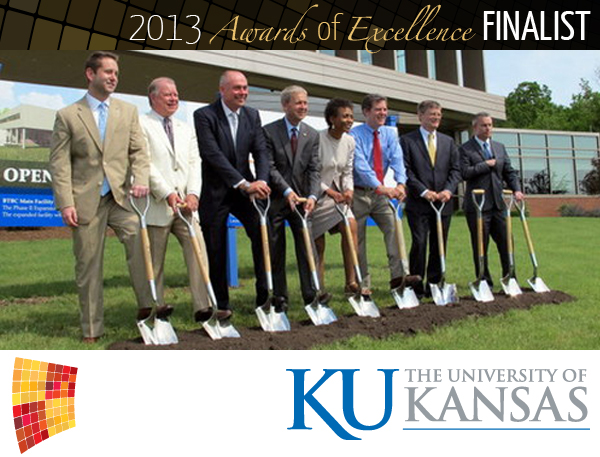Network

| Award Category: | Community Connected Campus |
| Project Site: | Collaborative Formation and Development of the Bioscience & Technology Business Center at the University of Kansas |
| Submitted By: | University of Kansas / KU Center for Technology Commercialization (Affiliate) |
| Contact: | Julie Goonewardene, 785.864.7824 |
Case Study
Abstract
The University of Kansas has forged an innovative commercialization eco-system in partnership with the Bioscience & Technology Business Center (BTBC). The partnership is unique in that it acknowledges the limited resources of a small Midwestern community and creates a novel combination of university, government, and private resources focused on technology-based economic development. Early backing from the Lawrence Chamber of Commerce led to modest but sustained commitments of city, county and state funding. These commitments leveraged larger investments by the Kansas Bioscience Authority and KU itself. The BTBC serves as KU’s incubator and also provides space for existing companies wishing to partner with KU. In concert with the development of this unique model KU raised the stature of commercialization through its strategic plan, Bold Aspirations. The KU Center for Technology Commercialization (KUCTC) is the single commercialization enterprise for the university with tech transfer, company formation, and industry partnerships centralized into one organization for both the main campus and the medical center. This structure provides a pipeline to the BTBC. Together, KUCTC and BTBC have become the university’s champion in support of community-engaged economic development. The tangible success of this partnership is measurable. For 2012, KU reported $10 million in licensing revenues — a tenfold increase over 2012. Company start-ups and industry-sponsored research have increased. The BTBC is also growing. A 30,000 square foot expansion will house multiple new tenants as well as the KUCTC. This move further signals the culture change and the next inflection point for the university’s economic development mission.
Problem/Background
In the past, the University of Kansas (KU) was often viewed by policy makers and business leaders as an underperforming economic development asset in the state. KU’s considerable research strengths were not translating into enough private sector commerce, and KU lacked a clear and coherent vision of its economic development mission. By 2000, it had become a local, regional, and state priority to grow an entrepreneurial business community, especially in the biosciences sector. This was the impetus for the creation of a multi-stakeholder, bi-state, Kansas City Area Life Sciences Institute (2001), as well as passage of the Kansas Economic Growth Act (2004), which established the Kansas Bioscience Authority as a novel funding mechanism for university research and business development in the state. In 2004, the Lawrence Chamber of Commerce commissioned a study of the local potential for a bioscience industry. That study prompted the formation of the Lawrence-Douglas County Bioscience Authority (LDCBA), funded initially by modest but sustained city and county appropriations. The lack of business incubator facilities and programs for KU-based start-ups and other companies was identified early on as a significant local shortcoming. KU was an active participant in all of these discussions and began to envision itself as a key player in local and state economic development efforts. Over time, KU naturally emerged as the leading research university and technology commercialization center in the region, and the primary advocate (and the logical location) for mixed-use incubators in both Lawrence and Kansas City.
Solution
The first task was to build an effective alliance of economic development stakeholders where none existed. This alliance was led by the LDCBA, with KU at its hub, based on the university’s research portfolio and faculty expertise, as well as access to talented students, lab facilities, and other resources. This alliance included a unique mix of city and county government, the Lawrence Chamber of Commerce, the KU Endowment (foundation), and KU itself through the bi-campus KU Center for Technology Commercialization. A second task was to envision the mission, functions, funding, and locations for a business incubator system, as well as the entrepreneurial eco-system needed to support such a system at the KU campuses in Lawrence and Kansas City. Working together, the alliance created a business model, generated a site plan and architectural renderings for a phased building project in Lawrence, and formulated a strategy for gaining immediate and ongoing political and financial support.
This alliance became even stronger as plans gelled for a $7.25 million Main Facility incubator – the Bioscience & Technology Business Center (BTBC) – on KU’s west campus “Research Circle” in Lawrence. No one organization had the funding, staffing, leadership or political clout to bring the project to fruition. The most innovative aspect of the collaboration – now led by the BTBC (successor in name to LDCBA) and the KUCTC – was the unique alliance which brought and continues to bring resources to the table. Government partners had to be convinced and lobbied to make 10-year commitments of scarce dollars in the midst of the Great Recession. The Chamber focused originally on the project as a local job-creation effort, but was educated along the way about the larger economic value of university research in the community. KU senior leadership committed staff support and funding early on and was instrumental in obtaining a multi-year commitment from the new Kansas Bioscience Authority. KU Endowment provided land for the BTBC Main Facility. With funding lined up and a clear plan in place, a groundbreaking ceremony in 2009 was followed in 2010 by a dedication ceremony and the arrival of the first tenant.
Parallel with these activities and vital to their success, KU was aggressively ramping up its staffing and funding in support of the BTBC and the university’s emerging economic development mission. The formation of the KUCTC in 2009 – uniting separate and fragmented technology transfer offices at the Lawrence and Medical Center campuses – was an essential part of the campus-community equation. While the KUCTC is responsible for the management of KU’s intellectual property, it is also the focal point for licensing revenue agreements, company start-ups, and industry relations. Newly created leadership positions, involving nationally recognized experts, include an Associate Vice Chancellor for Innovation and Entrepreneurship in 2010, a Director of Industrial Partnerships in 2011, and a Director of KUCTC in 2012. The KUCTC has emerged as KU’s high-profile organizational structure for its state, regional, and national outreach to private sector enterprises.
Results
By 2012, the BTBC Main Facility was already full (in terms of tenant companies and their employees), an Expansion Facility had opened elsewhere in Lawrence, and a research facility at the KU Medical Center in Kansas City was renovated to provide a third BTBC location. In June 2013, ground was broken for the $10 million Phase II expansion of the Main Facility, with 75% of the funding provided by KU and KU Endowment sources, in collaboration with city and county government. Building upon the unique alliance model, the BTBC has become the largest system of business incubators in Kansas and one of the largest in the Midwest. By any standard, the BTBC has more than met the partner organizations’ original job-creation and investment mandate, and has done so several years ahead of schedule.
The speed with which the BTBC system has emerged is one of its most remarkable features. The Expansion Facility, acquired in 2010, is adjacent to a KU research facility located three miles west of the central campus. It is now home to a successful and growing research relationship between KU’s Center for Environmentally Beneficial Catalysis and agribusiness giant Archer Daniels Midland. The BTBC at the KU Medical Center opened in 2011 and is already nearing capacity. Its tenants include a promising KU start-up company, Likarda, LLC, co-founded by a prominent KU diabetes researcher and based on her patent-protected technology for treating chronic conditions common to companion animals.
The Phase II expansion of the Main Facility, when completed in 2014, will accommodate KU start-ups, other early-stage companies, and established firms collaborating with KU researchers. It will become headquarters for the KUCTC.
Phase II will also include student incubator space for a new program – The Catalyst – a collaboration with the Center for Entrepreneurship in the KU School of Business. The Catalyst will encourage students to commercialize ideas as part of their educational experience at KU. It will provide a support structure for those ventures, providing an incentive for graduates to locate their early stage companies in Kansas.
As for the KUCTC, it has increased KU’s licensing revenues tenfold compared to 2012, start-ups and corporate sponsored research have greatly increased, and KU has found its proper role as an economic development asset in the state. The successful alliance with the BTBC was an inflection point for the university in terms of its economic development mission. It signaled a new day for KU’s campus culture and the way in which policy makers and the business community view research and the university. The KUCTC continues to lead this culture change. During the past year, for example, it sponsored a “KU Entrepreneurship Boot Camp,” attended by 200 faculty and staff, the first “KU Innovation Fair,” featuring 25 student-produced poster presentations, and an annual award for an outstanding faculty entrepreneur. (The 2013 award went to the co-founder of Likarda, LLC.)
Future Considerations
The campus-community momentum generated by the formation and initial development of the BTBC is growing. The KUCTC is launching an industry-friendly website as a portal for potential collaborators and licensees, and has recently partnered with the KU School of Business to create the new position of Assistant Director of Corporate Partnerships. The KUCTC is in the process of rebranding itself as KU Innovation and Collaboration, in preparation for its relocation to the BTBC Main Facility Phase II in 2014. It is also working with KU Endowment to develop a philanthropy venture fund for KU start-ups. All of this activity represents a major shift in thinking at KU that promises to have an even greater impact on the university and the state in years to come.
Moving forward, the KU culture change is also mandated by Bold Aspirations, KU’s 2012-17 strategic plan. An important strategy under the plan is “Promote active entrepreneurship and vibrant external partnerships.” Action items include: “Develop a comprehensive plan to engage the KU community in entrepreneurial activities”; “Expand the commercialization of KU technologies and the incubation of KU start-ups”; and “Build high-level partnerships with business and external partners to advance key priorities.” KUCTC is the principal campus champion for this strategy and the related action items, and its activities are closely aligned with the expectations of Bold Aspirations.
As for the BTBC, it has already begun planning for subsequent phases on KU’s west campus in Lawrence. This will spark development of a true community-connected university innovation and research park. Such a park will offer “graduation” space for expanding BTBC tenants that want to remain closely connected to KU and all it has to offer. A park will also offer facilities funded and occupied by private industry in such fields as bioscience, technology, banking, and financing. Plans also include space for state and federal research facilities, and a conference center to further the study and promotion of commercialized research and economic development.
The June 14, 2013 groundbreaking for Phase II of the BTBC Main Facility provided a glimpse of things to come. Kansas Governor Sam Brownback spoke at the ceremony, along with KU Chancellor Bernadette Gray-Little, Lawrence Mayor Mike Dever, and Doug Cleverly, founder and managing director of Argenta, a New Zealand-based animal health company that has established a presence in the BTBC. “The BTBC is already more successful than we dreamed it would be,” said BTBC Executive Chairman LaVerne Epp. He described the groundbreaking as a “public signpost of success in fulfillment of the BTBC mission: `Transforming Ideas into Commerce.’” He added: “That mission, and the vision behind it, was untested at the first groundbreaking in 2009. The concept was sound, the pieces were in place, and the funding partners were firmly committed. The big question was `Will it fly?’ I’m pleased to report that the BTBC is soaring!” He concluded: “We are reminded every day that the research productivity of the University of Kansas is a major economic asset of the state. A key resource and ally in that effort is the KUCTC, which will relocate to the Main Facility next year. The KUCTC brings KU research innovations to market, promotes an entrepreneurial spirit on campus, and attracts industry research collaborations. We look forward to having an even closer relationship with them in the future.”
The KUCTC/BTBC partnership has a firm and sustainable foundation, based on the initial success and other considerations. These include the urgency of obtaining non-federal sources of research funding, the importance of demonstrating KU’s economic impact to the public, and the awareness that prominent and entrepreneurial faculty are drawn to universities that support innovation.
The partnership provides a model for how communities and universities of any size can pool resources and join complementary strengths to create an effective business incubator, one that provides space and services to a variety of tenants important to a university economic development eco-system. The BTBC project emerged at a challenging moment – before and during the Great Recession – when business community and political will (local, regional, state) coincided with the recognition that faculty expertise, university research, campus lab space and equipment, ready access to student employees/interns, and influential senior leadership are valuable economic assets. At the same time, KU recognized it was underperforming in this arena and had no clear economic development strategy. The university’s partnership with BTBC demonstrated and supported the need for a more aggressive technology commercialization organization – the KUCTC – than existed previously. The project also helped the university change its internal culture, helping it formulate and articulate a permanent commitment to economic development through the management of intellectual property and licensing, corporate partnerships, start-up companies, and community-engaged research.
Any university struggling to establish and sustain a well-developed economic development mission, based on marshaling its own assets and building on a closer relationship with local and state government and business leaders, could utilize the KUCTC/BTBC partnership model. In this instance, a major national research university went from “zero to 60” in just a few years, in terms of how it listened to its business and political stakeholders and worked with them to achieve common goals. Smaller regional universities with modest research programs and smaller communities with fewer resources can accomplish the same goal on a smaller scale based on local needs. The key is that no one partner has all the answers or the funding to launch a successful operation of any size in isolation. Engaging with local and state government as equals, along with the university and its affiliates (e.g., the university’s foundation, with its landholdings and cachet among a national network of alumni and donors), is the essential ingredient, both for initial success and sustained growth.
Finalist Presentation
UEDA Awards of Excellence Finalists presented at the Annual Summit in Pittsburgh on October 28, 2013. Summit attendees then voted for the best initiative in each category.

